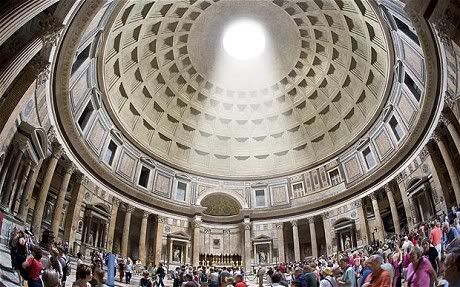See other History Articles
Title: Rome's Pantheon may have been built as a massive sundial researchers reveal
Source:
The Telegraph
URL Source: http://www.telegraph.co.uk/news/wor ... undial-researchers-reveal.html
Published: Aug 1, 2011
Author: Nick Squires
Post Date: 2011-08-03 12:50:15 by X-15
Keywords: Rome, Pantheon
Views: 80
Comments: 2
It is one of the best preserved buildings from the Roman world, a 2,000-year-old testament to the immense power and wealth of the empire. But mystery has always surrounded what lies behind the unusual design of the Pantheon, a giant temple in the heart of Rome that was built by the Emperor Hadrian. Now experts have come up with an intriguing theory – that the temple acted as a colossal sun dial, with a beam of light illuminating its enormous entrance at the precise moment that the emperor entered the building. Constructed on Hadrian's orders and completed in AD128, the Pantheon's hemispherical dome is punctured by a 30ft-wide circular hole known as the 'oculus'. It provides the interior of the building with its only source of natural light and allows in rain and – on rare occasions – snow. Giulio Magli, a historian of ancient architecture from Milan Polytechnic, Italy, and Robert Hannah, a classics scholar from the University of Otago in New Zealand, have discovered that at precisely midday during the March equinox, a circular shaft of light shines through the oculus and illuminates the Pantheon's imposing entrance.

Post Comment Private Reply Ignore Thread
Top • Page Up • Full Thread • Page Down • Bottom/Latest
#1. To: X-15 (#0)
Interesting. One of the oldest is New Grange in Ireland. 3500 BC.
One day a year (or maybe two) doesn't seem sufficient to inspire such a massive building project. The oculus is pretty much in the center of the structure and it just seems probable that it was intended as a skylight and a vent for fresh air, with the light's position at certain times on certain days just a happy coincidence.
#2. To: X-15 (#0)
Top • Page Up • Full Thread • Page Down • Bottom/Latest